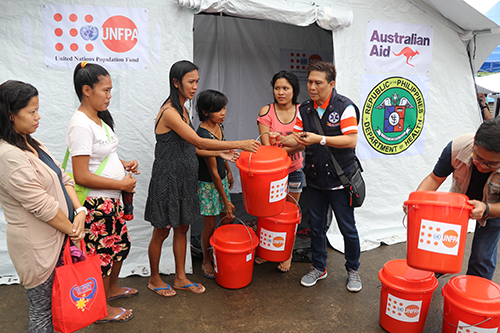News
Mayon volcano eruption displaces pregnant women and new mothers in Philippines
- 22 February 2018
News
LEGAZPI, Philippines – “I was washing clothes near my house when I heard the eruption from Mayon Volcano,” Jiassal Balatinsayo, 37, told UNFPA. Eight months pregnant and residing just over 6 km from the volcano erupting in the village of Santa Misericordia, Ms. Balatinsayo fled with her husband on 17 January.
“It was a very loud eruption, and I was very nervous,” Ms. Balatinsayo recalled.
She, her husband and their five children made the difficult journey to the San Andres evacuation centre, where they have been ever since.
The Mount Mayon volcano, located in Albay Province, 300 km southeast of the country’s capital, Manila, continues to show high levels of volatility. The provincial government of Albay is planning a three-month evacuation of area residents in case the volcanic activity worsens.

The unpredictable situation has left evacuees no choice but to abandon their homes and livelihoods for an extended period.
Over 88,000 people have been affected so far, with about 550 pregnant women and 1,720 breastfeeding mothers sheltering in evacuation centres, according to February data from regional health authorities.
UNFPA estimates there could be as many as 2,500 pregnant women among the affected population, with around 800 of them expected to deliver in the next three months.
These women require prenatal and post-partum health care, as well as help maintaining proper hygiene and nutrition.
“It is very hard here in the evacuation centre,” Ms. Balatinsayo told UNFPA, “especially when you have to use the toilet.” The toilets in the centre are shared, and evacuees have to bring their own water.
Although the San Andres evacuation centre lies on elevated ground, lava and lahar flow from a major eruption could isolate the area from the rest of the province. A similar situation occurred during the 2009 Mayon volcano eruption, which cut off San Andres’s access to the nearest hospital.
“Women and girls are more vulnerable in emergencies and have specific needs. They need access to services for safe pregnancy and childbirth,” said Klaus Beck, UNFPA’s Representative in the Philippines.

In partnership with the Department of Health, and with support from Australia, UNFPA has deployed an emergency maternity tent facility in the San Andres evacuation centre. The tent will help ensure access to safe deliveries for pregnant women staying in the evacuation centre as well as those living with friends and relatives in the area.
The tent is staffed by a doctor and a team of nurses and midwives from the Department of Health. It is equipped with the medical equipment and supplies required for normal deliveries.
“The availability of services for pregnant women is now right here for them, and they don’t have to go to a farther area,” Philippine Assistant Secretary of Health Dr. Nestor Santiago explained.
Ms. Balantinsayo gave birth to a healthy girl. A day after the tent was set up, she became the first woman to access reproductive health services there.
“I’m so happy that I’ve given birth and all is okay,” Ms. Balatinsayo said, resting in a bed after receiving post-partum care. “Now I hope the Mayon volcano stops erupting so that we can go home.”
– Mario Villamor